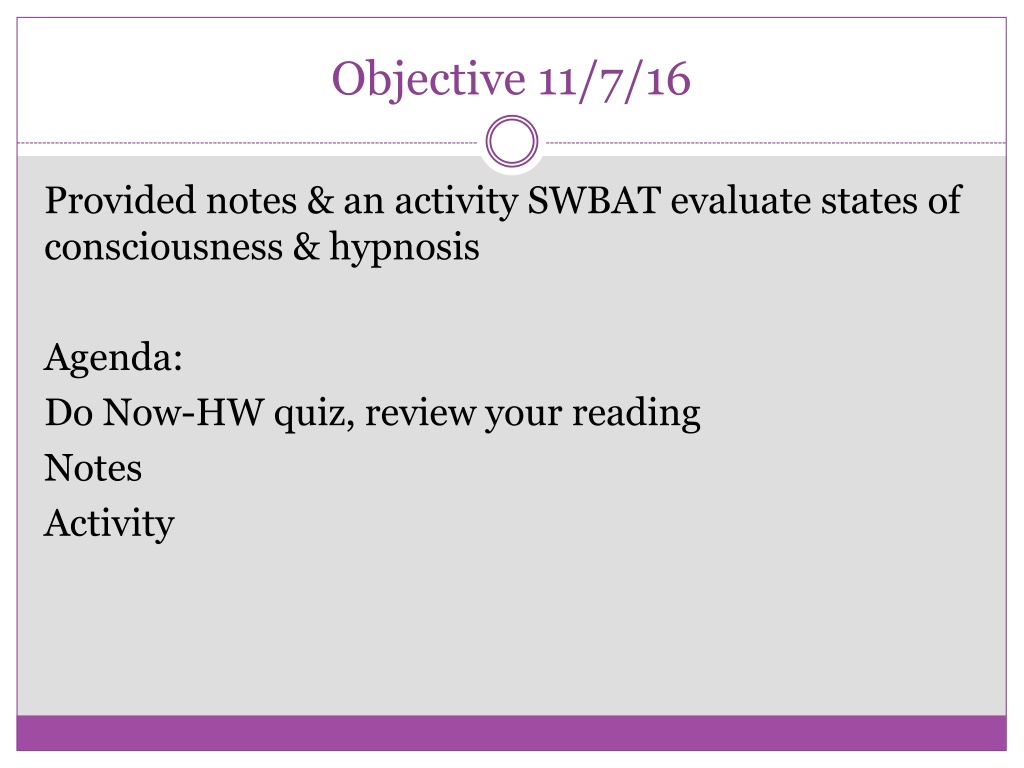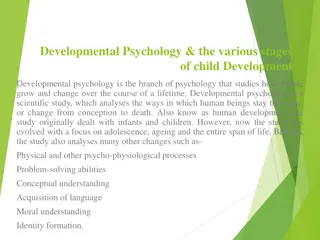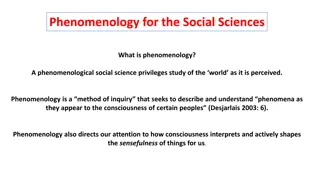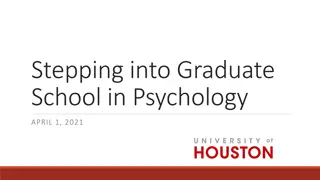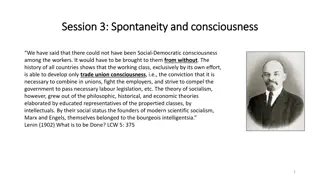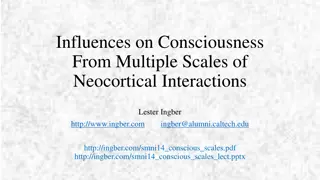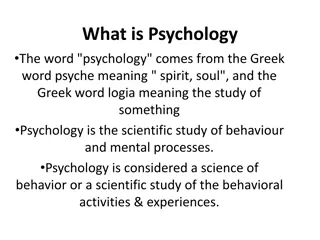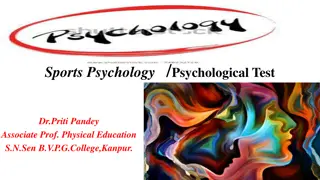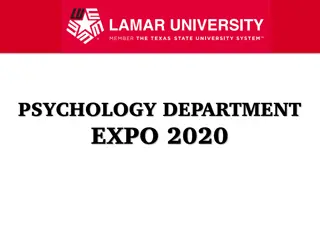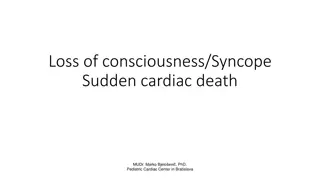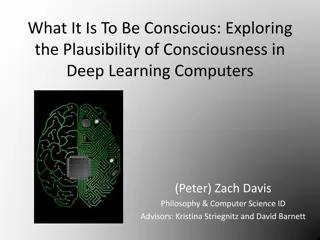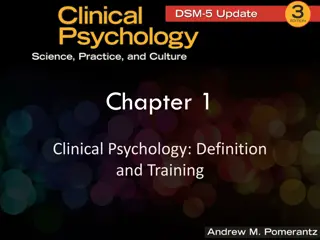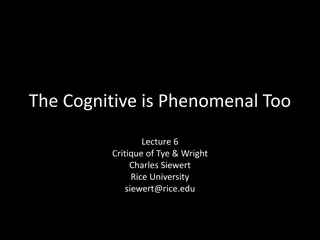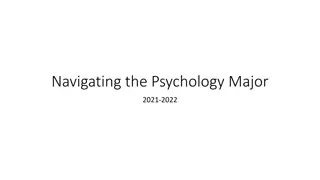Understanding States of Consciousness and Hypnosis in Psychology
Explore the concept of consciousness and hypnosis in psychology through a series of engaging activities. Delve into topics such as the capacity of consciousness, dream analysis, and the effects of hypnosis on behavior. Gain insights into the basics of consciousness and its role in shaping our awareness and experiences.
Download Presentation

Please find below an Image/Link to download the presentation.
The content on the website is provided AS IS for your information and personal use only. It may not be sold, licensed, or shared on other websites without obtaining consent from the author. Download presentation by click this link. If you encounter any issues during the download, it is possible that the publisher has removed the file from their server.
E N D
Presentation Transcript
Objective 11/7/16 Provided notes & an activity SWBAT evaluate states of consciousness & hypnosis Agenda: Do Now-HW quiz, review your reading Notes Activity
Psychology: Consciousness AP PSYCHOLOGY: UNIT 4 Topic: States of Consciousness
Activity: Fact or Falsehood? Consciousness has an unlimited capacity False Most university students are evening persons whose performance improves throughout the day True People who sleep seven to eight hours a night tend to outlive those who are chronically sleep deprived True
Activity: Fact or Falsehood? The most common dreams are those with sexual imagery False The majority of characters in men s dreams are female False Most psychologists believe that dreams provide a key to understanding our inner conflicts False
Activity: Fact or Falsehood? Under hypnosis, people can be induced to perform feats they would otherwise find impossible False Under hypnosis, people can be induced to perform feats they would otherwise find immoral False
Activity: Fact or Falsehood? Those given morphine to control pain often become addicted to the drug False In large amounts, alcohol is a depressant; in small amounts, it is a stimulant False
Consciousness: The Basics Consciousness Awareness of oneself and one s environment Both internal & external stimuli Contents are continuously changing Consciousness rarely comes to a standstill Allows for organization, reflection and planning
Consciousness: The Basics Includes Your awareness of external events Oh no! My professor just asked me a question about medieval history that I know NOTHING about Your awareness of sensations My heart is racing & I m starting to sweat Your awareness of yourself as the unique being that is having these experiences Why me?? Your awareness of your thoughts regarding these experiences I m going to make a fool out of myself!
Consciousness: The Basics Waking Consciousness State in which thoughts, feelings & sensations are clear and organized; person feels alert Theories of Waking Consciousness The Stream of Consciousness William James Sweeping or scanning 40 times per second; each sweep results in a single image or moment of consciousness Iceberg Theory Sigmund Freud Consciousness is NOT an all-or-nothing phenomenon
The conscious mind processes information sequentially; it is slow and limited The unconscious mind processes information simultaneously on multiple tracks
Consciousness: The Basics Altered States of Consciousness State in which there is a shift in the quality or pattern of mental activity as compared to waking consciousness Is it possible to divide one s conscious awareness? YES!
Consciousness: The Basics SOME OCCUR SPONTANEOUSLY Daydreaming Drowsiness Dreaming SOME ARE PHYSIOLOGICALLY INDUCED Food or oxygen starvation Hallucinations Orgasm SOME ARE PSYCHOLOGICALLY INDUCED Sensory deprivation Hypnosis Meditation Altered States of Consciousness
Consciousness: The Basics Most common altered state? Sleep; humans spend approximately one-third of their lives sleeping Do humans maintain awareness during sleep? YES; some stimuli are able to penetrate awareness during sleep
Consciousness: The Basics Where does consciousness come from? Most psychologists believe that it arises from activity in networks of neural pathways in the brain How do scientists measure consciousness? Electroencephalograph (EEG) Summarizes electrical activity in terms of brain waves Brain waves vary in: Amplitude (height) Frequency (cycles per second, cps)
Consciousness: The Basics EEG Pattern Frequency Typical States of Consciousness Beta 13-24 Normal waking thought, alert problem solving Alpha 8-12 Deep relaxation, blank mind, meditation Theta 4-7 Light sleep Delta Less than 4 Deep sleep Brain Wave Patterns Chicken-or-Egg Puzzle: If you become drowsy while reading your textbook (which I m sure you never do), your brain-wave activity will probably change. But are these changes causing your drowsiness, or is your drowsiness causing the changes in brain-wave activity?
Consciousness: Hypnosis 8 out of 10 people can be hypnotized 4 out of 10 people will make good subjects Altered consciousness or role playing?
Consciousness: Hypnosis Hypnosis State of consciousness in which the subject is especially susceptible to suggestion Four Steps in Hypnosis Focus on what is being said Relax and feel tired Let go and accept suggestions Use vivid imagination Alternate Definition: Merely a blend of conformity, relaxation, imagination, obedience, suggestion and role-playing
Consciousness: Hypnosis Posthypnotic Suggestion Suggestion made during session; carried out after hypnosis Has been shown to help to alleviate headaches, asthma, skin disorders etc. Dissociation A split of mental processes into two separate, simultaneous streams of awareness Has been shown to provide hypnotic pain relief
Consciousness: Hypnosis Hypnosis CAN Create amnesia for anything that happens during the session, at least for a brief period of time Hypnosis CANNOT Give people superhuman strength Relieve pain by allowing a person to remove conscious attention from the pain Reliably enhance memory Alter sensory perceptions such as smell, hearing, vision and time sense Regress people back to childhood Help people relax in situations that would normally cause them stress Regress people to some past life
Consciousness: Theories of Hypnosis
Theory: Divided Consciousness Ernest Hilgard (1994) Also know as The Hidden Observer Theory Hypnosis is a special state of dissociated, or divided consciousness Hypnosis works on the immediate consciousness, while another part of the subject s mind (the hidden observer ) remains aware of all that is going on Similar to behavior that occurs on autopilot
Theory: Social-Cognitive Irving Kirsch (2000) Also known as Social Influence Theory People who are hypnotized are not in an altered state consciousness, but rather playing the role expected of them in the given situation Subjects might actually believe that they are hypnotized; often unaware that they are role-playing Highlights the power of social influences
Consciousness: Meditation PART FIVE
Consciousness: Meditation Meditation A family of practices that train attention to heighten awareness and bring mental processes under greater voluntary control A deliberate effort to alter consciousness Rooted in what?
Consciousness: Meditation Two Primary Approaches Focused Attention Attention is concentrated on a specific object, image, sound or bodily sensation Intent is to narrow attention & clear mind of its clutter Open-Monitoring Attention is directed to one s moment-to-moment experience; nonjudgmental Intent is to become a detached observer
